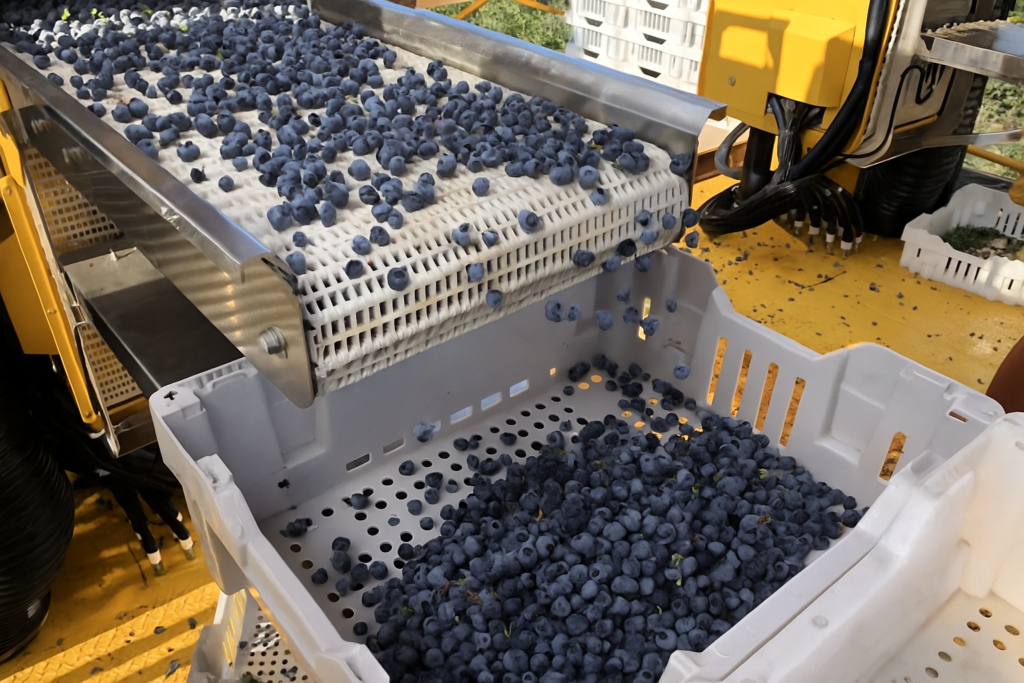Blueberries are rich in antioxidants, vitamins, and flavor — but their high moisture content makes them highly perishable. Drying is one of the most effective methods to extend their shelf life while preserving their nutritional and organoleptic qualities.
According to the United States Department of Agriculture (USDA), blueberries rank high on the list of the food that’s rich in antioxidants, which implies they’re useful to fight illness. Therefore blueberries are considered a kind of superfood.

Drying Methods for Blueberries
- Sun Drying Method
Sun-drying is the most basic and traditional way of drying blueberries, which uses solar energy as the heat source, and is working well in the hot, dry climates. Sun-drying needs a long drying period, and the drying result can be influenced by weather and environment easily, but it is still considered as an effective method for food preservation in many places around the world.
- Hot-air Drying Method
Hot-air drying is one of the oldest methods of drying food products. In this process, blueberries are continuously introduced to flowing hot air to remove their moisture. Hot-air drying is less affected by climate and hygienic conditions, but the blueberry size, the physical flow path, temperature, humidity and velocity of the air, and the design of the drying equipment affect the drying time and rate.
- Hot air circulation drying oven for Blueberries
Hot air circulation drying oven is a kind of widely-used hot air drying machines for blueberries dehydration. It is working by the fan and heater device to realize circulatory hot air supply to remove the moisture content of blueberries. We manufacture quality hot air circulation drying oven that can be powered by electricity, steam, far infrared and hot water. And we can customize the dehydrating oven based on customers’ requirements on the working capacity. Here is the video of the operation of hot air circulation fruit drying oven.
- Microwave Drying Method
Microwave drying technology use has been increased a lot, because it can produce food products of better quality than that produced in sun-drying and hot-air drying, with substantially decreased drying time, fast drying speed and high efficiency. In microwave drying, the heat generated by the rotation of water molecules and ionic particles heats the blueberry to evaporate its moisture, and the drying result is mostly affected by microwave power and drying temperature.
- Freeze Drying Method
Freeze drying is one of the most sophisticated methods of drying. The freeze dry blueberry maintains all of the nutrients with minus water and intense flavor. Traditionally, freeze drying is to use flash freezing and vacuum process to remove moisture from blueberries to a mere 2% or less while retaining their original color and shape.
- Vacuum Drying Method
The moisture of blueberries can be removed under a low-pressure environment during vacuum drying, thus blueberries are dried at low temperature, causing quality drying result.
Vacuum-belt Drying Method Vacuum-belt drying is a new drying method that can be used for fruit or fruit juice dehydrating. When drying blueberries, the product is introduced through an airlock and is conveyed by a belt over a series of plate heater to accomplish moisture removal.
- Osmotic Drying Method
In osmotic dehydrating, fresh or frozen blueberries are dipped in a soda solution to soften the skin and then are soaked in a syrup or fruit juice concentrate solution. The liquid (syrup or fruit juice concentrate) is specially projected to be heavier than the interior moisture of the blueberry and also fid the microscopic pores. The liquid will enter the interior through osmosis and drives the water from the blueberry. When the syrup or juice is fully absorbed, the process is completed with air drying to the desired moisture level.
Among these ways, freeze drying is the most costly and is especially utilized in manufacturing high-value product when the reservation of functional components in blueberries is required. Osmotic dehydration has wide use in blueberry processing because it will remove a large quantity of water from fruits without causing phase changes, load the expensive fruits with cheap sugar, and increase product weight. Hot air drying technique is utilized to dehydrate fresh, frozen and sugar-infused blueberries to shelf-life moisture content. However, hot air drying takes prolonged drying time, which results in degradation of heat sensitive components and discoloration of the final product. Microwave drying has been studied for achieving fast drying and reducing the quality loss of fruits and vegetables. Vacuum drying is an applicable technique for heat and oxygen sensitive foods. Featured by minimal quality loss, drying convenience and low cost, vacuum-belt drying is considered as a good method for hygroscopic and sticky-pastry products.
One common process of blueberries is to make them dry by reducing their moisture content to a low level, to induce better preservation, or to have more processing. Dried blueberries are around for a long time since they were invented by Native American and 1st Nation in Canada. Dried blueberries are great and ideal for baking, snacks and topping cereal, to make the blueberry-based foods delicious and nutritious. At a similar time, dried blueberries are found to improve vision, clear arteries, strengthen blood vessels, enhance memory, stop urinary tract infection, reverse age-related physical and mental declines, and promote weight management.
At Kerone, with decades of experience in custom-designed drying systems, we explore how various drying methods impact the quality, efficiency, and commercial viability of dried blueberries.
Choosing the right drying method for blueberries depends on your product goals, budget, and scale of production. At Kerone, we specialize in designing and manufacturing custom drying systems tailored to diverse industrial needs — from hot air and infrared to cutting-edge microwave vacuum and freeze-drying systems.
Whether you’re looking to preserve the vibrant color and nutrients of blueberries or optimize your energy usage, Kerone’s expertise ensures you get the right solution with precision and reliability.
